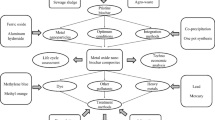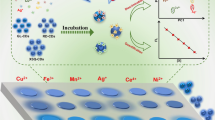Abstract
Selenium is a required micronutrient at low concentrations, while it becomes toxic at high concentrations. Inorganic selenium exists mainly as SeO3 2− (selenite or Se(IV)) and SeO4 2− (selenate or Se(VI)). Currently, few biosensors can effectively measure these selenium species in water. In this work, we study the adsorption of selenite/selenate by various metal oxide nanoparticles including CeO2, CoO, Cr2O3, Fe2O3, Fe3O4, In2O3, Mn2O3, NiO, TiO2, and ZnO. Fluorescently-labeled DNA molecules are used as probes and first adsorbed on these oxides, resulting in quenched fluorescence. Upon addition of selenite, the DNA probes are displaced from the surface with fluorescence recovered for six out of the ten oxides, while the response to selenate was much lower in all the cases. The signaling is optimal below 400 mM NaCl at near neutral pH when Fe3O4 nanoparticles were used. Quantitative studies were performed on three oxides with detection limits for selenite being 0.3 μM (CeO2), 2.0 μM (Fe3O4), and 3.0 μM (Fe2O3), respectively. The system, however, is also responsive to a few other anions such as phosphate and arsenate. Therefore, it can be used as a method for analyzing selenium species when the system is known to be free of such competing anions. This study represents the first effort of designing selenite sensors using DNA as probes, and it may stimulate related work for this important analyte.






Similar content being viewed by others
References
Sanz Alaejos M, Diaz Romero C. Analysis of selenium in body fluids: a review. Chem Rev. 1995;95:227–57.
Conde JE, Sanz Alaejos M. Selenium concentrations in natural and environmental waters. Chem Rev. 1997;97:1979–2004.
Jordan N, Ritter A, Scheinost AC, Weiss S, Schild D, Hübner R. Selenium(IV) uptake by maghemite (γ-Fe2O3). Environ Sci Technol. 2014;48:1665–74.
Szlachta M, Gerda V, Chubar N. Adsorption of arsenite and selenite using an inorganic ion exchanger based on Fe–Mn hydrous oxide. J Colloid Interf Sci. 2012;365:213–21.
Scheinost AC, Charlet L. Selenite reduction by mackinawite, magnetite and siderite: XAS characterization of nanosized redox products. Environ Sci Technol. 2008;42:1984–9.
Duc M, Lefèvre G, Fédoroff M. Sorption of selenite ions on hematite. J Colloid Interf Sci. 2006;298:556–63.
Yamani JS, Lounsbury AW, Zimmerman JB. Adsorption of selenite and selenate by nanocrystalline aluminum oxide, neat and impregnated in chitosan beads. Water Res. 2014;50:373–81.
Elzinga EJ, Tang Y, McDonald J, DeSisto S, Reeder RJ. Macroscopic and spectroscopic characterization of selenate, selenite, and chromate adsorption at the solid–water interface of γ-Al2O3. J Colloid Interf Sci. 2009;340:153–9.
Jordan N, Foerstendorf H, Weiß S, Heim K, Schild D, Brendler V. Sorption of selenium(VI) onto anatase: Macroscopic and microscopic characterization. Geochim Cosmochim Acta. 2011;75:1519–30.
Peak D, Sparks DL. Mechanisms of selenate adsorption on iron oxides and hydroxides. Environ Sci Technol. 2002;36:1460–6.
Manceau A, Charlet L. The mechanism of selenate adsorption on goethite and hydrous ferric-oxide. J Colloid Interf Sci. 1994;168:87–93.
Paikaray S, Hendry MJ, Essilfie-Dughan J. Controls on arsenate, molybdate, and selenate uptake by hydrotalcite-like layered double hydroxides. ChemGeol. 2013;345:130–8.
Saritha K, Nanda Kumar NV. Qualitative detection of selenium in fortified soil and water samples by a paper chromatographic–carboxyl esterase enzyme inhibition technique. J Chromatogr A. 2001;919:223–8.
Costas-Mora I, Romero V, Pena-Pereira F, Lavilla I, Bendicho C. Quantum dot-based headspace single-drop microextraction technique for optical sensing of volatile species. Anal Chem. 2011;83:2388–93.
Costas-Mora I, Romero V, Pena-Pereira F, Lavilla I, Bendicho C. Quantum dots confined in an organic drop as luminescent probes for detection of selenium by microfluorospectrometry after hydridation: Study of the quenching mechanism and analytical performance. Anal Chem. 2012;84:4452–9.
Dwivedi S, AlKhedhairy AA, Ahamed M, Musarrat J. Biomimetic synthesis of selenium nanospheres by bacterial strain JS-11 and its role as a biosensor for nanotoxicity assessment: A novel se-bioassay. PLoS One. 2013;8:e57404.
Liu J, Cao Z, Lu Y. Functional nucleic acid sensors. Chem Rev. 2009;109:1948–98.
Wang H, Yang RH, Yang L, Tan WH. Nucleic acid conjugated nanomaterials for enhanced molecular recognition. ACS Nano. 2009;3:2451–60.
Li D, Song SP, Fan CH. Target-responsive structural switching for nucleic acid-based sensors. Acc Chem Res. 2010;43:631–41.
Willner I, Shlyahovsky B, Zayats M, Willner B. DNAzymes for sensing, nanobiotechnology and logic gate applications. Chem Soc Rev. 2008;37:1153–65.
Zhao W, Brook MA, Li Y. Design of gold nanoparticle-based colorimetric biosensing assays. Chem Bio Chem. 2008;9:2363–71.
Xiang Y, Lu Y. DNA as sensors and imaging agents for metal ions. Inorg Chem. 2014;53:1925–42.
Raven KP, Jain A, Loeppert RH. Arsenite and arsenate adsorption on ferrihydrite: Kinetics, equilibrium, and adsorption envelopes. Environ Sci Technol. 1998;32:344–9.
Liu B, Liu J. DNA adsorption by magnetic iron oxide nanoparticles and its application for arsenate detection. Chem Commun. 2014;50:8568–70.
Liu B, Liu J. Comprehensive screen of metal oxide nanoparticles for DNA adsorption, fluorescence quenching, and anion discrimination. ACS Appl Mater Inter. 2015;7:24833–8.
Lopez A, Zhang Y, Liu J. Tuning DNA adsorption affinity and density on metal oxide and phosphate for improved arsenate detection. J Colloid Interf Sci. 2017;493:249–56.
Liu B, Sun Z, Huang P-JJ, Liu J. Hydrogen peroxide displacing DNA from nanoceria: Mechanism and detection of glucose in serum. J Am Chem Soc. 2015;137:1290–5.
Liu B, Huang Z, Liu J. Boosting the oxidase mimicking activity of nanoceria by fluoride capping: Rivaling protein enzymes and ultrasensitive F− detection. Nanoscale. 2016;8:13562–7.
Pautler R, Kelly EY, Huang P-JJ, Cao J, Liu B, Liu J. Attaching DNA to nanoceria: Regulating oxidase activity and fluorescence quenching. ACS Appl Mater Inter. 2013;5:6820–5.
Zhang X, Wang F, Liu B, Kelly EY, Servos MR, Liu J. Adsorption of DNA oligonucleotides by titanium dioxide nanoparticles. Langmuir. 2014;30:839–45.
Zhang P, Sparks DL. Kinetics of selenate and selenite adsorption/desorption at the goethite/water interface. Environ Sci Technol. 1990;24:1848–56.
Su CM, Suarez DL. Selenate and selenite sorption on iron oxides: an infrared and electrophoretic study. Soil Sci Soc Am J. 2000;64:101–11.
Pei H, Li J, Lv M, Wang J, Gao J, Lu J, et al. A graphene-based sensor array for high-precision and adaptive target identification with ensemble aptamers. J Am Chem Soc. 2012;134:13843–9.
De M, Rana S, Akpinar H, Miranda OR, Arvizo RR, Bunz UHF, et al. Sensing of proteins in human serum using conjugates of nanoparticles and green fluorescent protein. Nat Chem. 2009;1:461–5.
Acknowledgements
Funding for this work is from the NSERC of Canada (Discovery and Strategic Project Grant: STPGP-447472-2013 055766).
Author information
Authors and Affiliations
Corresponding author
Electronic supplementary material
Below is the link to the electronic supplementary material.
About this article
Cite this article
Yu, T., Liu, B. & Liu, J. Adsorption of Selenite and Selenate by Metal Oxides Studied with Fluorescent DNA Probes for Analytical Application. J. Anal. Test. 1, 2 (2017). https://doi.org/10.1007/s41664-017-0001-0
Received:
Accepted:
Published:
DOI: https://doi.org/10.1007/s41664-017-0001-0




